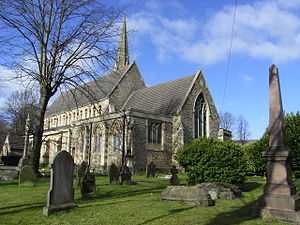St Mark's Church, Swindon
| St Mark's Church, Swindon | |
|---|---|
|
St Mark's Church, Swindon, from the southeast | |
 St Mark's Church, Swindon Location in Wiltshire | |
| Coordinates: 51°33′40″N 1°47′41″W / 51.5612°N 1.7947°W | |
| OS grid reference | SU 143 847 |
| Location | Church Place, Swindon, Wiltshire |
| Country | England |
| Denomination | Anglican |
| Churchmanship | Traditional Catholic |
| Website | St Mark. Swindon |
| History | |
| Dedication | Saint Mark |
| Dedicated | 25 April 1845 |
| Architecture | |
| Status | Parish church |
| Functional status | Active |
| Heritage designation | Grade II |
| Designated | 2 October 1951 |
| Architect(s) | Scott and Moffatt, Temple Moore |
| Architectural type | Church |
| Style | Gothic Revival |
| Groundbreaking | 1843 |
| Completed | 1897 |
| Specifications | |
| Spire height | 140 feet (43 m) |
| Materials | Limestone, roofed in tiles and lead |
| Administration | |
| Parish | Swindon New Town |
| Deanery | Swindon |
| Archdeaconry | Malmesbury |
| Diocese | Bristol |
| Province | Canterbury |
| Clergy | |
| Priest(s) | Fr Dexter Bracey |
| Laity | |
| Churchwarden(s) | John Bishop, Julie Emmett |
| Parish administrator | Karen Vermeersch |
St Mark's Church is in Church Place, Swindon, Wiltshire, England. It is an active Anglican parish church in the deanery of Swindon, the archdeaconry of Malmesbury, and the diocese of Bristol. Its benefice is united with those of St Aldhelm, Swindon, St Luke, Swindon, and St Saviour, Swindon, to form the benefice of Swindon New Town.[1] The church is recorded in the National Heritage List for England as a designated Grade II listed building.[2]
History
St Mark's was built to serve workers of the Great Western Railway, whose Swindon Works were nearby. George Henry Gibbs, the head of the firm of Anthony Gibbs and Sons, died in 1842, and bequeathed £500 towards building a church and a school in the town. In February 1843, the railway company appealed for contributions from the public, and a total of £6,000 (£520,000 in 2015)[3] was raised to build the church.[4] The church was designed by George Gilbert Scott and William Moffatt, and built between 1843 and 1845.[2] It was dedicated to St Mark on 25 April 1845, St Mark's Day.[4] In 1897 Temple Moore added a north vestry.[2]
Architecture
Exterior
The church is constructed in limestone with roofs of tiles and lead. Its plan consists of a five-bay nave with a clerestory, a north aisle and a south aisle with a three-bay chapel, a south porch, a three-bay chancel with a south chapel and a north vestry, and a north steeple opposite the porch. It is in Decorated Gothic style. The tower is in four stages, and has a north door, angle buttresses, and two-light louvred bell openings. It is surmounted by a crocketted spire with lucarnes rising to 140 feet (43 m). At the west end of the nave is a doorway and a window with five lights containing curvilinear tracery. Along the sides of the aisles are two-light windows with tracery in varying styles. The east window in the chancel has three lights.[2]
Interior
Inside the church, the arcades are carried on quatrefoil piers. The nave has a hammerbeam roof, and the roof of the chancel is barrel vaulted. The stained glass includes windows by Kempe.[2] The pipe organ was built in 1922 by Jardine of Manchester. It was rebuilt in 1961 by Percy Daniel of Clevedon. In 1973 the organ was destroyed by fire and Persy Daniel replaced it with a three-manual organ moved from a redundant church in the north of England.[5] There is a ring of eight bells. Six of these were cast in 1904 by Llewellins and James, and the other two in 1927 by Mears and Stainbank of the Whitechapel Bell Foundry.[6]
Musical tradition
St Mark's has a long tradition of performing choral music in the style of an English cathedral. The choir sings at the weekly Parish Mass and at other services, has a repertoire of over 30 masses, and has recorded two CDs.[7] In 1944 Benjamin Britten composed his Festival Te Deum for the centenary of the church, where it was first performed on 24 April 1945.[8][9] While Mr. Britten attended the rehearsal, earlier in the day, he declined to attend the performance due to the poor quality of the performers.
References
- ↑ St Mark, Swindon, Church of England, retrieved 17 November 2013
- ↑ 2.0 2.1 2.2 2.3 2.4 Historic England, "Church of St Mark, Swindon (1355898)", National Heritage List for England, retrieved 17 November 2013
- ↑ UK CPI inflation numbers based on data available from Gregory Clark (2014), "What Were the British Earnings and Prices Then? (New Series)" MeasuringWorth.
- ↑ 4.0 4.1 A Brief History of S. Mark's Church, Parish of Swindon New Town, retrieved 17 November 2013
- ↑ Wiltshire Swindon, St. Mark, Church Place, New Town )N10283), British Institute of Organ Studies, retrieved 17 November 2013
- ↑ Swindon, S Mark, Dove's Guide for Church Bell Ringers, retrieved 17 November 2013
- ↑ Our History, St Mark's Choir, retrieved 17 November 2013
- ↑ Britten, Benjamin: Festival Te Deum, Boosey & Hawkes, retrieved 17 November 2013
- ↑ Festival Te Deum in E, Op 32, Hyperion Records, retrieved 17 November 2013
